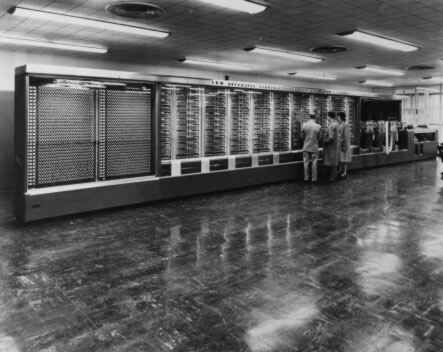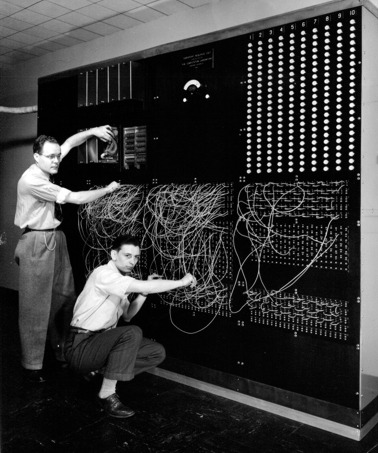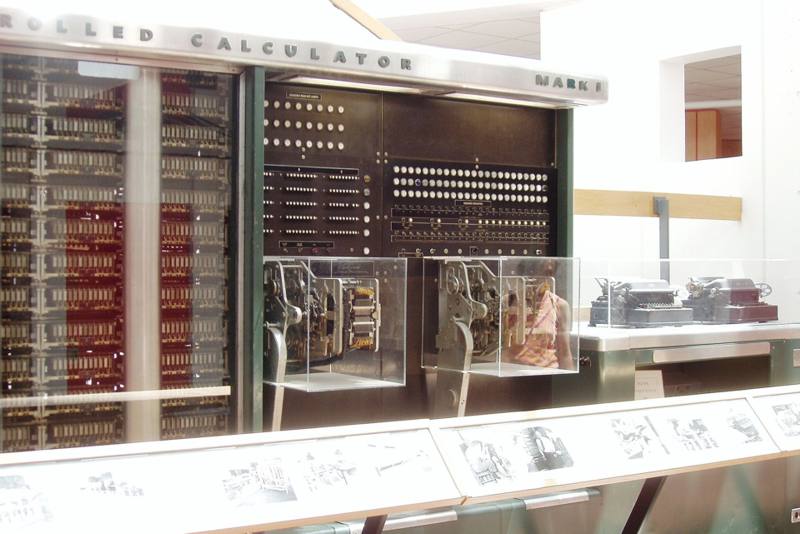| 70 Years Ago - Formal Presentation of Harvard Mark 1 |
| Written by Historian | |||
| Thursday, 07 August 2014 | |||
|
The computer dreamed up by Howard Aiken and built with financial help from IBM was formally presented to Harvard University on August 7, 1944. At the time the Harvard Mark 1, had already been put to work. It had been delivered from IBM's Endicott plant to Harvard University in February 1944 where it was ranged along the wall of its huge computer room. Measuring fifty one feet long and eight feet high, it weighed five tons.
At least 530 miles of cable were used together with 175,000 plug connections, 3500 relays and, more unusual for a computer, 1200 ball bearings! The panels at the left-hand end allowed 60 constants to be set using 1400 dial switches. Next came 72 storage counters each holding 23 digits plus sign. These were used in addition, subtractions and as accumulators and took up one third of the machine.
Havard Mark 1 in use, 1944 Source: Computer History Museum
A bank of multipliers and dividers came next followed by functional units which could calculate logs, anti logs and trigonometric functions. Three paper tape feed interpolators allowed tabulated functions to be fed into the calculation. The operation of all of the computational units was controlled by an electro mechanical sequencer and finally a bank of electric typewriters, card feeds and card punch completed the machine. The instructions, i.e. the program, for the Mark I was fed in via a fourth paper tape reader.
Harvard Mark I Computer - Right Segment Source: Wikipedia.
One of the first programs to run on it was a calculation done at the end of March by John Von Neumann who was working on the Manhattan project and wanted to determine whether implosion was a good way to detonate the atomic bomb. In May it began computations for the U.S. Navy Bureau of Ships with Howard Aiken, who joked that he was the first person to be commanding officer of a computer, in charge. Under naval control the Mark I was run as a military machine. Its operators would march around the highly polished floor and salute each other when ever it was required by protocol! According to one Harvard scientist who saw it in action its attendants "appeared to operate the thing while at attention!"
Its display cabinet now describes the machine as "Aiken - IBM Automatic Sequence Controlled Calculator". This is accurate in that it was Aiken's proposal and it was IBM that financed it to the tune of $5million and built it, but the long established tension between Aiken and Thomas Watson Sr came to a head at the presentation on August 7, 1944. Aiken and Watson had disagreed about how the machine should look - a small detail but it gives you some idea of the differences between the two. Aiken wanted everything to be on view so that scientists could see how it worked. Watson on the other hand wanted it encased in stainless steel shaped and curved into a modernistic symbol of the new age. Watson won but lost the next round. At the dedication of the machine Aiken did not mention Watson and arranged a press conference that gave the impression that he, Aiken, was the brains behind the mechanical brain. Watson was furious. Later his son, Tom Watson Jr, recalled that if the two men had had guns there would have been a shoot out. Watson resented Aiken for 20 years and IBM top management remembered the insult for a lot longer. Read more on this history in Howard Aiken and the Harvard Mark I
More InformationRelated ArticlesHoward Aiken and the Harvard Mark I Grace Hopper - The Mother of Cobol Google Doodle Celebrates Grace Hopper's Birthday Father of IBM Born On This Day In 1874
To be informed about new articles on I Programmer, install the I Programmer Toolbar, subscribe to the RSS feed, follow us on, Twitter, Facebook, Google+ or Linkedin, or sign up for our weekly newsletter.
Comments
or email your comment to: comments@i-programmer.info
|
|||
| Last Updated ( Tuesday, 12 August 2014 ) |





